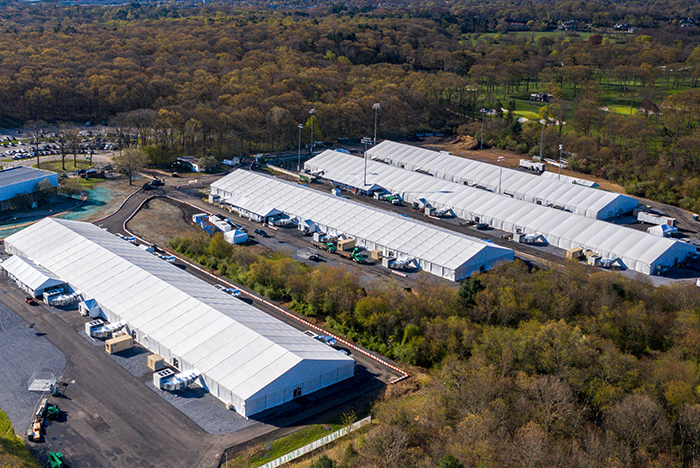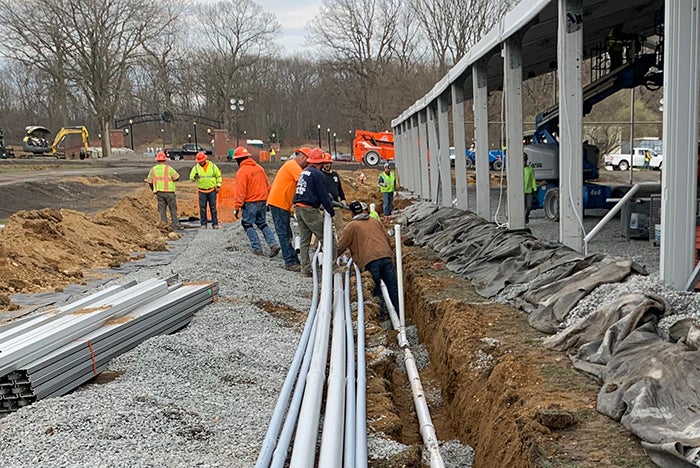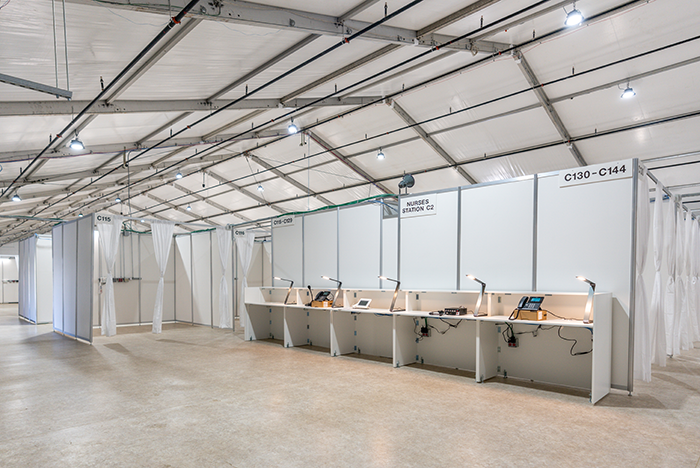Rapid construction for emergency care

Aerial image shows the four tents that helped to provide more than 1,000 beds to absorb increased patient demand during the COVID-19 pandemic.
Image courtesy of AECOM
After New York went into a pandemic lockdown on March 13, 2020, Chris Pell, a senior associate at JB&B, an engineering consulting firm headquartered in New York City, was working in his home office for a week when he received a call to commission a 1,024-bed alternate care site (tent hospital) at the athletic facilities of State University of New York (SUNY) Old Westbury, located in a village of Long Island, N.Y. The project included four large tents and the university’s gym, each equipped with nurses stations, bathrooms, showers, medical gas systems, and associated mechanical, electrical and plumbing infrastructure. In just 28 days, the AECOM-led design-build team completed the facility, including design, construction and commissioning.
“Day 1 we showed up, there was an empty gym and empty baseball fields,” Pell explains. “Day 28, there were four tents, which along with the gym, had been converted into space for over 1,000 hospital beds.”
Ensuring the operational functionality of all systems and components is crucial for health care facilities to meet the requirements of health care teams. As an emergency response to the COVID-19 pandemic, the facility had to prepare to treat illnesses of varying severities, prioritize infection control and ensure the safety of staff and patients as the COVID-19 response progressed.
Day 1 team building
Due to the extremely tight time frame, the team quickly adapted to expedite tasks. During construction projects, various components operate independently, and teams may isolate themselves with distinct goals. Collaboration can prevent errors, reduce rework, boost productivity and enhance morale on-site; but it takes time to get to know everyone, understand their roles, strengths, weaknesses and form a cohesive unit. However, on a 28-day project, team building must occur almost immediately for efficient work.

Construction workers installing electrical conduit for the alternate care site.
Image courtesy of AECOM
“The normal team building process that you usually have the luxury of at least weeks if not months to unfold, that happened in the span of hours to maybe a day here,” Pell says.
The project's success hinged on the full functionality of equipment operation and system interconnections within the critical facility. Unlike a conventional health care project with consistent equipment in each patient room, the Old Westbury project required the team to use available equipment, resulting in slight differences in the equipment serving each space, despite similar usage and operation. Commissioning providers had to dynamically adjust functional tests to accommodate minor variations between manufacturers and equipment performance.
“Early, consistent involvement from someone with a commissioning mindset was hugely important to the project” Pell explains.
The commissioning provider acts as a bridge between the silos of various disciplines, as they examine the big picture and commission various individual scopes and interconnections. The commissioning team at Old Westbury collaborated with designers to identify operational or constructability issues and made changes on the fly, allowing contractors to focus on building.
To meet the project deadline, most of the team, from design to commissioning, were physically present on-site throughout construction and in constant communication with the remainder of the design team working remotely. A workforce of up to 500 people worked around the clock to complete the project. They operated in two 10-hour shifts, with two hours between each shift for sanitization. This occurred during the early stages of the COVID-19-pandemic before much was known about the virus's transmission, severity or lasting impact.
A united mission
The project thrived on a major commonality: Everyone united around the goal of creating a facility for COVID-19 patients. This common purpose naturally brought the team together at the project’s outset. Guided by a mission directive from the Federal Emergency Management Agency and the U.S. Army Corps of Engineers (USACE), the project leaders employed a military mindset of physical and mental resilience, staying focused to complete the project. They also drew on their experience in rapidly mobilizing large-scale operations to keep the team on track. Failure was not an option.

A view of the nurses station in the tent facility.
Image courtesy of AECOM
The project sharpened the focus on priorities, leaving no room for egos or disputes. The primary concern was finishing the project and providing a functional facility for health care teams to treat patients effectively. All parties had to engage in transparent and open communication to ensure value for the end-user, address arising problems, find solutions and comprehend the reasonable time frames for each task, ensuring the project’s continuous progression. Accountability from every team member also played a role in building trust and ensuring fulfillment of commitments.
In a traditional health care project, the facility is expected to operate for decades, with each clinical department dependent on having the necessary infrastructure in the right locations. However, certain departments are too often excluded from design and construction, often only visiting the site after the space is complete. At that point, revising device locations or room orientations can be challenging and costly. Involving health care end-users early in the process can help eliminate rework by understanding how they plan to use the space and where value can be added.
“The mission from USACE allowed us to focus on the singular mission and cut through some of the red tape that can often bog down traditional health care projects” Pell says.
Same place, same time
In the digital age, post-COVID-19, the design and construction field has transitioned to virtual meetings, project management software and emails as the primary means of communication. While these tools can be effective, this project underscored that “There's no replacement for the boots on the ground because without that this never would have worked, especially in a complex building like a health care environment,” Pell says. “The design engineers, the architect, everybody was all there in the same space, looking at the same things, speaking the same language.”
Most health care projects take years to complete and lack the budget to have the entire team on-site full time. However, the Old Westbury alternate care site project reinforced that bringing everyone together at critical points in the project was more beneficial to resolve conflicts that span multiple disciplines in a quick and efficient manner.
Health care projects require additional considerations because of the criticality of their life safety systems, concerns for patient safety and 24/7 operation. The Building Commissioning Association (BCxA) Best Practices outline the fundamental principles of commissioning for various types of buildings.
Editor's note: The American Society for Health Care Engineering (ASHE) and the Building Commissioning Association are partnering to promote building commissioning and create educational tools for members of both organizations. This partnership includes the revision of ASHE’s Health Facility Commissioning Handbook and "Health Facility Commissioning Guidelines." New editions of these resources are expected to release in 2025. Current versions of both resources are on sale in the ASHE store.
Nicole Imeson, P.L. (Eng.), is co-founder of Vertica Engineering, based in Calgary, Alberta.




